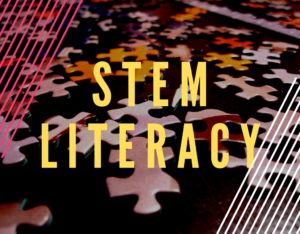With all the new school curriculums, extracurricular activities, and library programs popping up within the last few years, you may have noticed the buzz around the importance of STEM education in elementary schools. As a youth services librarian getting an increasing number of inquiries from parents about it, I decided to do some research to learn more about what it is, how it’s being used, and how it can help students in elementary school.
Why is STEM education important in elementary schools? The U.S. has fallen behind other countries in STEM-related fields. An integrated approach to teaching science, technology, engineering, and math fosters innovation through critical thinking and provides children with a strong foundation needed to play a part in the nation’s global competitiveness.
Although STEM education is recommended to start at early childhood, it is still effective and important if started after. Our nation, without question, needs a skilled workforce to succeed in the global arena. That’s why it is being implemented in schools across the country. Other advantages of STEM-skilled students over non-STEM-skilled students include generally higher pay and future job growth. To provide all these benefits for elementary school students, STEM offers a more practical way to learn science, technology, engineering, and math.
Table of Contents
What Is the STEM Program In Schools?
Parents often ask what the STEM program in schools is. Usually, after parent-teacher meetings, they come into the library looking for STEM resources so they know their child is prepared for the school’s curriculum.
Since STEM education is relatively new, we must look at why it was created to understand what it is and what its goals are.
When Sputnik was launched by the Soviets, the United States started a mission to catch up in the race for space. This sparked a revolution that got children excited about science, technology, engineering, and math. This reverberated into the 1970s and 1980s with the first space shuttle launch and the first PCs triggered interest in science and technology. It advanced into the computer and dot-com era of the 1990s when children’s standardized test scores were declining.
As the U.S. realized that its children were not up to par with its competitors, including China, education in science, technology, engineering, and math started to become a significant concern with America’s economic and scientific leadership being at stake.
Since the acronym was created in the early 2000s, U.S. agencies have been looking for the best ways to educate children in science, technology, engineering, and math. Nationwide campaigns and grants were created to elevate student achievement and to reward innovative educational approaches and policies.
We are at an early stage in STEM education where educators are starting to find the best practices to be entered into their teachings. One thing we do know is that the STEM program in schools focuses on guiding students to acquire the skill-sets needed to join an increasingly dynamic workforce that will aid in our nation’s prosperity.
What Is STEM In Elementary School?
Because it has just started to become introduced into curriculums around the nation, we may be wondering what STEM education in elementary schools is in order to find its importance. Upon my research, I have found that it is not merely education in science, technology, engineering, and math. But, it is also not as complicated as the relatively new term that is often associated with robots may seem to be.
There is still an absence of an agreed-upon clear definition of STEM which makes it difficult for educators to come up with adequate programs. But, the one that I have found cited by researchers the most is the one that the Bureau of Labor Statistics (BLS) gives it. According to the BLS, “STEM workers use their knowledge in science, technology, engineering, and math to try to understand how the world works and to solve problems.”
STEM education is an integrated approach to teaching and learning its disciplines. It is designed to encourage students to be logical thinkers who can answer complex questions and develop solutions to problems.
Knowing this, you can say that educators enact the STEM model in their process. They are using data from policies and reports to experiment with their engineered STEM programs then statistically analyze the results to create scientific data. This scientific data is then used to tweak or enhance their engineered STEM projects and the cycle goes on.
How Is STEM Used In the Classroom?
The importance of STEM education in elementary schools can be seen revolving around how it is being taught in the classroom. The long-term goal of each lesson is to provide students with a foundation of skills needed for success in a STEM career.
To best integrate STEM into the classroom, teachers may look at what students are learning at the moment then try to shift it into a problem or question. Multiple subjects such as science, math, and social studies are grouped into a bundle that revolves around an issue that students can research and solve. Children are curious and problem solvers by nature, so these types of projects also tap into that.
Students may be learning STEM without even knowing it. Important STEM words like “experiment” and “model” are being added so students will be used to hearing them. Technology such as tablets, computers, and even smartphones are being introduced to children are better prepared for the future.
STEM lessons provide students with the opportunity to explore real-world scientific problems through hands-on experiences. A typical STEM lesson has students identify a real-world problem, ask questions to investigate the issue, develop solutions, and explore a hands-on activity.
An example of an elementary school STEM project would be pollution. Since students are taking earth science in these grades, they would be asked to find a way to reduce pollution in their environment. They are asked complex questions to engage in logical reasoning and may use technology for their research. Next, for engineering, students are asked to design or construct a solution to this real-world problem. Finally, for math, students interpret their data.
How Can STEM Help Students?
If you have read this far, you should know that STEM education is essential in elementary schools because of the foundational benefits attained that is critical to the future of our nation’s global rank. That sounds great for our country, but what does STEM do for the students themselves?
Here are a few ways STEM helps students:
- STEM-educated students may perform better on the SAT and ACT exams compared to non-STEM educated students. The extra math and science learned by students in a real-world context can help them learn more complex concepts. When STEM is integrated into a curriculum based on what the student is currently learning, students will have a more in-depth understanding of the subject that will stick with them longer.
- Students are prepared for the future workforce. STEM education fosters innovation through critical thinking and problem solving and provides the foundational skills of science, technology, engineering, and math. This helps students move seamlessly into postsecondary education and their career paths. You will find that and subject or field will require at least two of these skills.
- STEM provides future career potential. According to the U.S. Department of Commerce, two-thirds of STEM workers have a college degree or higher, STEM workers generally earn 26% more than non-STEM workers, and the yearly growth of STEM jobs is projected to be almost twice that of non-STEM jobs
- STEM promotes gender equality. It bridges the gap between male and female workers through special programs geared towards females.



